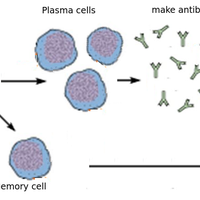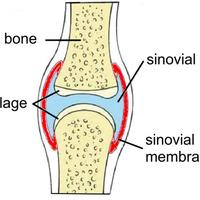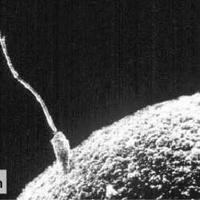 Topic 11: Animal physiology
Topic 11: Animal physiology
This is an introduction to the HL animal physiology topic. It lists understandings and skills expected for Topic 11 including antibody production by lymphocytes, vaccines, monoclonal antibodies, muscle fibres, actin and myosin, osmoregulation, kidney nephrons, oogenesis, spermatogenesis, pregnancy and birth. Helpful for revision.
Detailed revision notes, activities and questions can be found for each of the sub-topic pages:
- 11.1 Antibody production and vaccination
- 11.2 Movement
- 11.3 The kidney and osmoregulation
- 11.4 Sexual reproduction
11.1 Antibody production and vaccination
Cells & pathogens
- The surface of cells of an organism has unique molecules.
- Pathogens can be species-specific or can cross species barriers.
Antibody production involves the following:
- B lymphocytes are activated by T lymphocytes in mammals.
- Activated B lymphocytes multiply to form clones of plasma cells and memory cells (giving immunity).
- Plasma cells secrete antibodies which aid the destruction of pathogens.
- Other white blood cells release histamine in response to allergens which causes allergic symptoms.
Vaccination and monoclonal antibodies
- Vaccines contain antigens that trigger an immune response without causing the disease.
- Fusion of a tumour cell with an antibody-producing plasma cell creates a hybridoma cell.
- Monoclonal antibodies are produced by hybridoma cells
- Monoclonal antibodies to HCG are used in pregnancy test kits.
Skills & applications
- Smallpox was the first infectious disease of humans to have been eradicated by vaccination.
- Human vaccines are often produced using the immune responses of other animals
- Blood group antigens on the surface of red blood cells stimulate antibody production in a different blood group.
- Skills to analyse epidemiological data related to vaccination programmes.
11.2 Movement
Skeletons and muscles
- Bones and exoskeletons (e.g. insect legs) provide anchorage for muscles and act as levers.
- Synovial joints allow certain movements but not others.
- Muscles work in antagonistic pairs.
Muscle contraction
- Skeletal muscle fibres are multinucleate and contain
- specialised endoplasmic reticulum
- many myofibrils
- made up of contractile sarcomeres.
- The sliding of actin and myosin filaments causes contraction.
- Contraction requires ATP hydrolysis and cross bridge formation
- Calcium ions and the proteins tropomyosin and troponin control muscle contractions.
Skills & applications
- Know how to annotate a diagram of the human elbow. Include cartilage, synovial fluid, joint capsule, named bones and named antagonistic muscles.
- The ability to draw labelled diagrams of the structure of a sarcomere, including Z lines, actin filaments, myosin filaments with heads, and the resultant light and dark bands.
- The ability to find the state of contraction of muscle fibres in electron micrographs,
- Experience of measurement of the length of sarcomeres using calibration of the eyepiece scale of the microscope
11.3 The Kidney and osmoregulation
Control of water balances in different animals
- Some animals are osmoconformers - their cells have solute concentration equal to their environment (eg. marine invertebrates)
- Vertebrates and insects are osmoregulators. (so are some single cells, eg.Amoeba)
- Insects have malpighian tubules but vertebrates have kidneys to carry out osmoregulation and remove nitrogenous wastes.
- The type of nitrogenous waste in animals is correlated with evolutionary history and habitat.
Kidney structure & function
- The differences in composition of blood in the renal artery & the renal vein.
- Ultrafiltration helped by the ultrastructure of the glomerulus and Bowman’s capsule.
- Selective reabsorption of useful substances by active transport in the proximal convoluted tubule.
- The loop of Henle maintains hypertonic conditions in the medulla.
- ADH controls reabsorption of water in the collecting duct.
- The length of the loop of Henle is positively correlated with the need for water conservation in animals.
Skills & applications
- To be able to draw and label a diagram of the human kidney.
- To be able to annotate diagrams of the nephron. Including glomerulus, Bowman’s capsule, proximal convoluted tubule, loop of Henle, distal convoluted tubule; and the collecting duct
- To have considered the consequences of dehydration and overhydration.
- To know about treatment of kidney failure by hemodialysis or kidney transplant.
- To know about urinary test for Blood cells, glucose, proteins and drugs.
11.4 Sexual Reproduction
Gametogenesis
- Similarities in spermatogenesis and oogenesis include mitosis, cell growth, two divisions of meiosis and differentiation.
- Students need to be able to annotate diagrams of seminiferous tubule and ovary to showing these details.
- Differences between the processes in spermatogenesis and oogenesis are the different numbers of gametes produced and the different amounts of cytoplasm in these gametes.
- Annotation of diagrams of mature sperm and egg to indicate functions.
Fertilization
- Fertilization in animals can be internal or external.
- Fertilization involves the acrosome reaction, fusion of the plasma membrane of the egg and sperm and the cortical reaction. (mechanisms that prevent polyspermy)
Early growth of the embryo
- Implantation of the blastocyst in the endometrium is essential for the continuation of pregnancy.
- HCG stimulates the ovary to secrete progesterone during early pregnancy.
- The placenta facilitates the exchange of materials between the mother and fetus.
- Estrogen and progesterone are secreted by the placenta once it has formed.
- Birth is mediated by positive feedback involving estrogen and oxytocin.
Skills & applications
- To make comparisons of gestation periods and animal size & to find the place of the average human (38-week) pregnancy on a graph showing the correlation between animal size and the development of the young at birth in mammals.
- To annotate diagrams of stages of gametogenesis in seminiferous tubule and an ovary.
- Ability to annotate diagrams with the function of the parts of mature sperm and egg.

Antibody production & vaccination 11.1 HL
This topic covers the role of antigens in challenging the immune system leading to antibody production. Knowledge of B-lymphocytes, T-lymphocytes, memory cells and plasma cells and vaccination as a method of promoting immunity.

Movement 11.2 HL
This topic covers the basic structure of joints and the role of bones and exoskeletons in movement before looking in detail at the structure of sarcomeres in skeletal muscles and the processes of the sliding filament theory.

Kidney and osmoregulation 11.3 HL
This topic looks at the interesting comcept of water balance in organisms. Insects control water balance using small Malphigian tubules unlike mammals and other vertebrates who have a kidney.

Sexual reproduction 11.4 HL
Sexual reproduction in this HL topic begins with spermatogenesis and oogenesis where gametes are made. This is followed by the process of fertilisation, the acrosome reaction and the cortical reaction. The development and implantation of a blastocyst.


 Twitter
Twitter  Facebook
Facebook  LinkedIn
LinkedIn